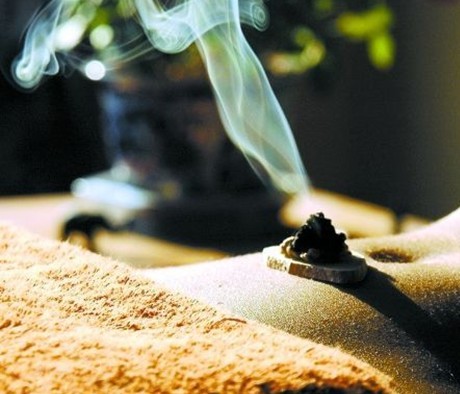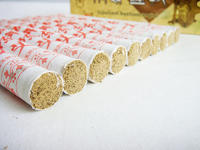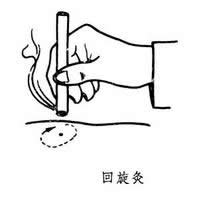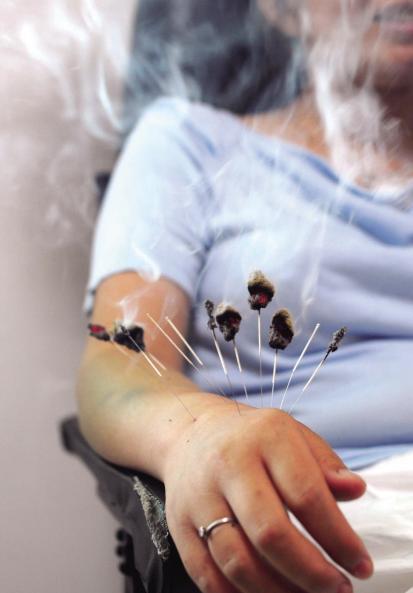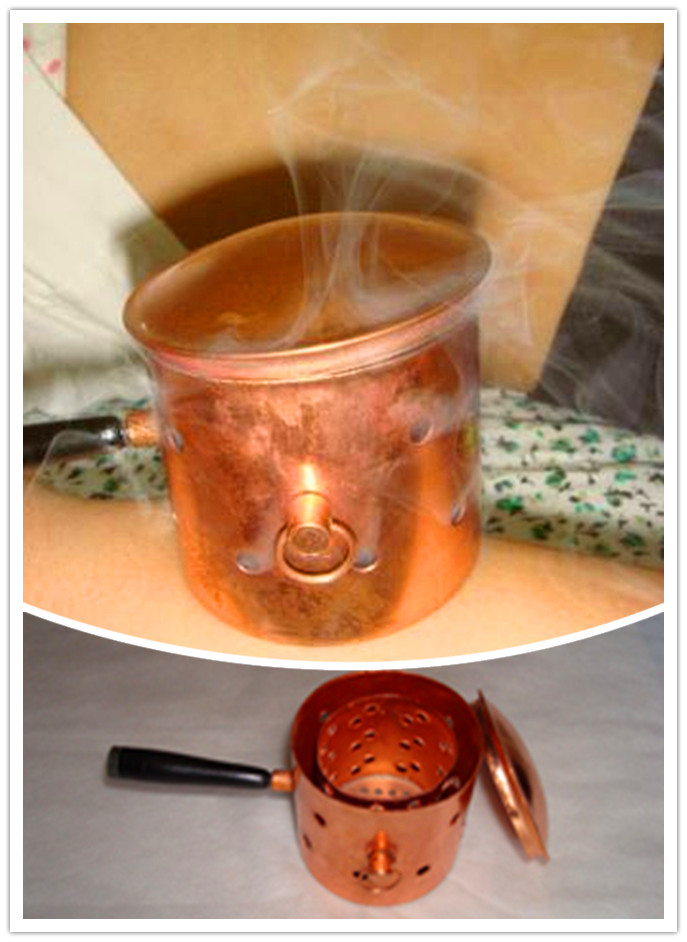Moxibustion
Moxibustion therapy literally means the burning of moxa. It is a therapy that can prevent and treat diseases with heat stimulation on acupoints or related parts of the body.
Moxa, the leaf of Artemisia Argyi, from the compositae family, is a perennial, herbaceous plant. Moxa is produced in all parts of China, yet the name of Jin Moxa, comes from the Jin Zhou area, where it is most famous. Due to its special aroma, bitter and pungent flavor and warm nature, as well as it's flammability and moderate heat, moxa surely is an ideal option——just as both Ben Cao Gang Mu (The Compendium of Materia Medica) and Ming Yi Bie Lu (The Great Physician’s Additional Records) mentioned, "Moxibustion can be applied in various diseases."; With dry, moxa leaves pounded and purified, fine, soft, moxa wool is thus made; and after being dried in the sun it is stored for future use. The reason for using old, dry moxa wool instead of fresh new wool, is that the latter contains so much volatile oil that when burned it gives off too much heat. So the best choice is moxa that has been dried for an extended period of time.
The Functions of Moxibustion
a. Warm the Meridians to Dispel Cold
Moxibustion can warm the meridians to dispel cold. Clinically, it is applied for all diseases caused by cold obstruction, blood stagnation and blockages of the meridians, such as cold-damp arthralgia, dysmenorrhea, amenorrhea, stomachache, epigastric pain and cold herniation.
b. Supporting Yang to Strengthen the Original Qi
It has been widely applied to many serious diseases due to insufficiency, sinking or depletion of yang qi. Among them are enuresis, rectocele, prolapse of the genitalia, menorrhagia, leukorrhea, and chronic diarrhea, just to name a few.
c. Remove Blood Stasis and Dissipate Pathological Accumulation
Moxibustion, with its heat, has the effect of keeping the actions of Yin qi and stomach qi in balance, and in turn, it dispels blood stasis and dissipates pathological accumulation. In the clinical setting, it is commonly used to treat diseases related to qi and blood stagnation, such as the early stages of acute mastitis, scrofula and goiter.
d. Prevent Disease and Maintain Health
Moxibustion on Zusanli (ST36) or other points, has the function of preventing diseases and maintaining health. It was called reverse moxibustion in ancient China, while nowadays, it is known as healthy moxibustion, which means maintaining the habit by doing moxibustion even though one enjoys good health. This method can invigorate healthy qi and strengthen the immunity to keep one full of vitality and increase longevity.
Moxibustion with Moxa
**1. Muxibustion with Moxa Cones (Zhuangs)**
Moxa-cones refer to burn moxa wool that has been shaped into small cones and placed on various parts of the body to treat illnesses. Moxibustion can be done with moxa cones made of moxa wool, on various parts of the body. Making moxa-cones is fairly easy, pure moxa wool is lain on a table where it is shaped and formed into different sizes—— small ones, the size of a grain of wheat, medium-sized ones, about half the size of a jujube date, and large ones, that are about the size of an olive. A moxa cone, is also known as a zhuang.
Moxibustion with moxa-cones is subdivided into direct and indirect moxibustion.
a. Direct Moxibustion
When a moxa cone is placed directly on an acupoint area and ignited it is called direct moxibustion. It is subdivided into scarring moxibustion, and none-scarring moxibustion. The former leaves a festering burn that left scars, while the latter does not produce such a strong stimulation, usually leaves no scars.
b. Indirect Moxibustion (Jian Jie Jiu):
This method, also known as moxibustion with material insulation, involves some form of insulation between the core and the skin, so that there is no direct contact. Various materials are used for insulation, however, those most common medicinal substances used are ginger, salt, garlic, and monkshood cake.
① Ginger Moxibustion (Ge Jiang Jiu)
Fresh ginger is cut into slices, each about 2~3cm wide and 0.2 ~0.3cm thick. Several needle holes are then punched into the slices that are then placed on the acupoints/areas selected. The moxa cone is then placed on top of the ginger slice where it is ignited and burned. When the cone has burned completely, and the ash is removed, it is replaced with another one and the procedure is repeated until all the cones required are finished. Usually, the local skin in the area being treated will become rosy, which is the desired effect. This method can warm the spleen and stomach to stop vomiting and disperse cold to relieve pain. Thus, it is indicated for symptoms related to cold, such as vomiting, abdominal pain, joint pain, etc.
② Garlic Moxibustion (Ge Suan Jiu)
Garlic cloves are cut into slices, each about 0.2 to 0.3 cm thick, then holes are punched into them (Note: garlic-mash may also be used). The garlic is then placed on the acupoints/areas selected and moxa cones are ignited and burned on top of them as described above. This method effectively eliminates heat and toxins, and it is also useful for killing parasites, so it is often used to treat scrofula, tuberculosis, and the early stages of skin ulcers and local swellings. It can clean away the heat evil or detoxify, and has a pesticidal function.
③ Salt Moxibustion (Ge Yan Jiu)
This method is also known as Shenque (CV8) moxibustion, as it is usually done on the umbilicus. First, the umbilicus is filled with salt to the level of the skin, followed by placing a large-sized moxa cone on top of the salt (or a slice of ginger); it is then ignited and burnt. When consumed, the ash is removed, and it is replaced with another until all the cones required have been consumed. Since this method is effect for restoring Yang collapse, it is used for treating yin/cold disorders, vomiting and diarrhea, and flaccid type wind-stroke. For example, when treating flaccid type wind-stroke, continuous moxibustion is applied until the patient's vital signs are steady——that is, his/her pulse can be palpated and the extremities have become warm.
④Monkshood Cake Moxibustion (Fu Zi Bing Jiu)
A cake of Monkshood is approximately 3cm in diameter and 0.3cm in thickness, and it is made of Monkshood powder mixed with alcohol. It is punched with several holes, and placed on the affected area where moxa cones are placed on top of it to be ignited and burnt. This method is useful for warming and strengthening the kidney-Yang and thus it is adopted to treat impotence, spermatorrhea, premature ejaculation, infertility and ruptured abscesses resistant to healing.
2. Moxibustion with Moxa Sticks
Moxibustion with moxa sticks refer to make the moxa sticklike, and applied on certain parts.
Moxa sticks are made in the following manner: Tightly roll 24 grams of soft, pure argyi wool with a sheet of soft, thin paper (26cm by 20cm). Roll it into a column approximately 1.5 inches in diameter, and then wrap it with soft, tough mulberry paper. A "pure moxa stick" has thus been made after sealing each end with glue. A "medicinal herbal moxa stick" is made by combining 6 grams each of the following special ingredients, and pounding them into a powder: Rou Gui / Cortex Cinnamom , Gan Jiang / Rhizoma Zingiberis , Ding Xiang / Flos Caryophylli, Du Huo / Radix Angelicae Pubescebtis, Xi Xin / Herba Asari, Bai Zhi / Radix Angelicae Dahuricae, Xiong Huang / Realgar, Cang Zhu / Rhizoma Atractylodis , Mo Yao / Myrrha, Ru Xiang / Olibanum and Chuan Jiao/ Pericarpium Zanthoxyli.
Moxibustion with moxa sticks includes two kinds: suspended and pressing moxibustion.
a. Suspended Moxibustion (Xuan Qi Jiu)
This method is done by holding the moxa stick over the acupoint / area during the treatment. Note: The end of the moxa stick should not make contact with the skin. It is sub-divided into mild-warming, sparrow-pecking and waving moxibustion.
① Mild Moxibustion (Wen He Jiu)
One end of a moxa stick is ignited and held over an acupoint / area. The distance between the end of the stick and the skin should be about 2 or 3 centimeters. The intention here is to bring warmth to the treatment area, so the patient should not feel any burning sensations, The practitioner should place their index and middle fingers on the sides of the affected area to feel the heat, so that they can determine and adjust the appropriate distance between the end of the stick and the patient's skin to avoid burning for patients in a coma or who have delayed / impaired sensory perception.
② Pecking Moxibustion (Que Zhuo Jiu)
With this method, the distance between the ignited end of a moxa stick and the patient's skin is not fixed. Instead, as its name indicates, it is moved up and down over the point / area like a pecking bird.
③ Waving (Painting) Moxibustion ( Hui Xuan Jiu)
When using this method, though the end of the moxa stick is kept 2 or 3 centimeters above the skin, it is moved back and forth or circularly.
b. Pressing Moxibustion (Shi An Jiu)
This method of moxibustion is done by pressing the burning end of a moxa stick, partitioned off by several layers of cloth or cotton paper, on the acupoints to allow the heat to penetrate the skin and muscle. After the fire is extinguished, it should be ignited again and repeated. The third Chapter of Shou Yu Shen Fang (The Magic Prescription) not only recorded this method, but also mentioned that it is useful for treating patients until they feel warmth in the abdomen, with sweating, then the patients will be healed. Taiyi moxa stick and Thunder-Fire Moxibustion is commonly used.
3. Warm-Needle Moxibustion (Wen Zhen Jiu)
Warm-Needle moxibustion is actually a combination of acupuncture and moxibustion. During the manipulation, after the arrival of qi, while the needle is still retained in the point, affix a small section of moxa stick (about 2cm long) on the needle's handle, and then ignite the moxa stick from its bottom. When the moxa stick burns out, remove the ash and take out the needle. This method is used when both retaining needles and moxibustion is indicated.
4. Moxibustion with a Moxa Burner (Wen Jiu Qi Jiu)
The mild-moxibustioner is a special instrument used for moxibustion. There are two kinds: the box and the canister. Both are commonly used in clinical practice. To use, place put some argyi wool, either alone or together with the special ingredients previously mentioned, into the box or canister. Ignite the argyi wool and make sure its lid is properly secured. Then, place it on the acupoints or affected area of the body to be treated. The desired effect is to make the local skin warm and flushed. This method of doing moxibustion is especially useful for children and other individuals who are afraid of being burnt by an open flame.
Order of Moxibustion
On this subject, explicit dissertations were given by the ancestors.Qian Jin Yang Fang • Zhen Jiu (Invaluable Prescriptions for Emergencies——Acupuncture and moxibustion) recorded moxibustion ought to be conducted on the yang aspect first, followed by the yin; and the upper area first, then the lower. Clinically, we should start moxibustion from the upper part of the body, to the lower part; first the yang aspect, then the yin aspect of the body. Initially, a small number of moxa cones should be applied; with additional treatment over a period of time, larger ones can be used. However, in special circumstances, these rules can be modified to coincide with the patient's condition.
Moxibustion Contraindications
A. In principle, patients with excess heat syndromes or with fevers due to yin deficiency are contraindicated for moxibustion. B. Scarring moxibustion is prohibited on the face and head, and areas close to large blood vessels. C. Moxibustion is prohibited on the abdomen and lumbo-sacral areas during pregnancy. D. Precautions should be taken with patients suffering from skin allergies or ulcers.
Useful links:
Brief introduction:
various moxibustion techniques: http://www.acupuncture-treatment.com/moxibustion.html
Frequently asked questions:
http://www.acupuncturetoday.com/abc/moxibustion.php
World Journal of Acupuncture-Moxibustion: http://www.wfas.org.cn/en/show.asp?men=7&class=316&liststate=0&Position=World%20Journal%20of%20Acupuncture-Moxibustion
thesis on moxibustion:
http://www.itmonline.org/arts/moxibustion.htm
moxibustion can help treat the following health problems:
- arthritis
- back pain
- headaches
- migraines
- muscle stiffness
- menstrual cramps
- digestive problems
- ulcers
- cancer
- infertility
- tendonitis
A new solution to stubborn pain:
World journal of moxibustion:


